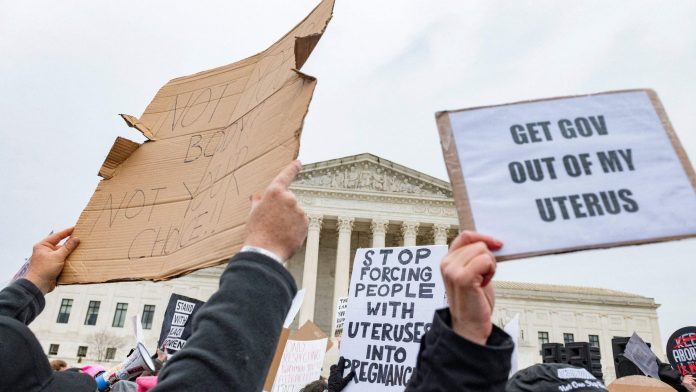Three years ago today, the U.S. Supreme Court issued one of its most consequential decisions in decades, overturning Roe v. Wade and ending the federal constitutional right to abortion. The Dobbs v. Jackson Women’s Health Organization ruling on June 24, 2022, did not settle the debate, but instead reignited it, shifting the fight to state legislatures, courts and ballot boxes across the country.
Abortion policy now varies sharply by state, reshaping health care access and deepening political divisions, with activists on both sides continuing to push for lasting change.
Data shows abortions increased last year
According to the Society of Family Planning’s #WeCount report, abortions rose in 2024, surpassing totals from both 2023 and 2022. A driving factor was the availability of mifepristone, commonly known as the abortion pill. Although most procedures still took place in person, the report said telehealth abortions steadily increased throughout the year. The organization has tracked national shifts in abortion since Roe v. Wade was overturned and reports that in 2024, abortions jumped to 1.14 million.
Data from December 2024 reported that one in four abortions were provided through telehealth. Shield laws played a growing role, helping people access medication abortion across state lines, with an average of 12,330 abortions per month provided under those protections by year’s end.
The Guttmacher Institute, a research and policy organization, reported a similar trend in 2024, with more than 1.04 million abortions performed in states without total bans. The data also showed a slight increase in access, with 1.5% more clinics providing abortion services when compared to 2023.
Where does abortion stand across the nation?
According to the Guttmacher Institute, 16 states currently enforce near-total abortion bans with limited exceptions, including Texas, Oklahoma, Florida, Louisiana, Iowa, Idaho and Missouri.
In 2024, Missouri voters approved a constitutional amendment to allow abortion up to fetal viability. But in May, state lawmakers passed a measure to repeal the amendment and limit abortion access to cases involving medical emergencies or fatal fetal anomalies. Now, voters will decide again in an upcoming election on abortion access.
California, Oregon and Vermont are among the states with the strongest legal protections for abortion. Each has enshrined abortion rights in its state constitution, making them some of the most protective states for reproductive care.
Are politicians still focused on abortion?
For many political candidates, abortion became a central campaign issue, either as a promise to protect access or a vow to restrict it. In the 2024 election, Democrats heavily emphasized abortion rights to help drive voter turnout. But in the months since President Donald Trump took office, the party has shifted its focus. Abortion is no longer the main issue. Instead, Democrats are now concentrating on immigration policy, deportation actions and proposed Medicaid cuts tied to a pending congressional spending bill.
During his first term, Trump nominated three Supreme Court justices who played key roles in overturning Roe v. Wade. He initially took credit for the decision, saying on social media, “I was able to kill Roe v. Wade.” But as he launched his bid for a second term, Trump softened his stance. He backed away from calls for a federal abortion ban and said the issue should be decided by individual states.
While Trump has moved on to other priorities, his administration has still moved to review abortion access. Health and Human Services Secretary Robert F. Kennedy Jr. has ordered a review of mifepristone. At the same time, Republicans in Congress are pushing to cut funding for Planned Parenthood in a major legislative package.
Support, opposition remains regarding Supreme Court decision
Communities across the country continue to mark the anniversary of the Roe v. Wade decision with rallies and marches, aiming to highlight reproductive rights and ongoing battles over abortion access.
Democratic congressional leaders are also calling for a renewed push for comprehensive legislation to expand reproductive healthcare. U.S. Rep. Ayanna Pressley, co-chair of the Reproductive Freedom Caucus, said she’s still committed to abortion care.
“Trump and Republicans are pushing their Big, Ugly Bill—cruel legislation that would destroy Medicaid as we know it, defund Planned Parenthood health centers, ban abortion coverage in private insurance plans on the ACA marketplace, and put essential care further out of reach for millions,” she said while marking the anniversary.
On the other side of the aisle, House Majority Leader Steve Scalise said today is a celebration of the protection of life.
“While we celebrate the pro-life protections that have taken effect because of Dobbs, Congressional Democrats are pushing barbaric legislation that would force unlimited abortion funded by taxpayers and force every state to allow abortion on demand through all nine months of pregnancy,” he said. “House Republicans will continue to be a firewall to prevent the Democrats’ radical abortion agenda from ever becoming law.”
What was the Supreme Court’s 2022 decision based on?
Dobbs v. Jackson Women’s Health Organization was a landmark case in which the U.S. Supreme Court overturned Roe v. Wade (1973) and Planned Parenthood v. Casey (1992), two decisions that had established and reaffirmed the constitutional right to abortion.
The case focused on a Mississippi law passed in 2018 that banned most abortions after 15 weeks of pregnancy. The cutoff was earlier than the viability standard set by Roe and Casey, which generally allowed abortions up to around 24 weeks. Jackson Women’s Health Organization, the last abortion clinic in Mississippi, challenged the law, arguing it violated the Constitution under existing precedent.
The court upheld the Mississippi law in a 6-3 vote. In a separate 5-4 vote, the justices also overturned Roe and Casey, ruling that the Constitution does not guarantee a right to abortion.
Justice Samuel Alito, writing for the majority, said, “The Constitution does not confer a right to abortion; Roe and Casey are overruled; and the authority to regulate abortion is returned to the people and their elected representatives.”

